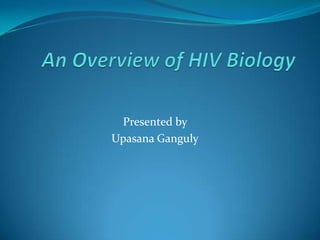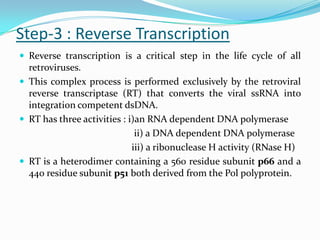An overview of hiv biology2 1.08.2011
- 2. •Acquired Immune Deficiency Syndrome (AIDS) is a disease of the human immune system caused by the Human Immunodeficiency Virus (HIV). •HIV infection in humans is considered pandemic by the World Health Organization (WHO). •UNAIDS estimated that 33.3 million people were living with HIV at the end of 2009.
- 3. Systemic position of HIV ÔÇó HIV is a complex retrovirus. ÔÇó A retrovirus is an RNA virus that is duplicated in a host cell using the reverse transcriptase enzyme to produce DNA from its RNA genome. ÔÇó HIV belongs to the Lentivirus genus of the Retroviridae family. ÔÇó Infections with lentiviruses typically show a chronic course of the disease, with long periods of clinical latency, persistent viral replication and involvement of the Central Nervous System.
- 4. HIV Variability: Types, Sub types and Groups  HIV variability is the consequence of i) “error-prone” mechanism of action of the viral enzyme reverse transcriptase ii) Very rapid viral replication iii) Occurrence of recombination between two or more HIV viruses within the same infected individual.
- 5. Origin of HIV  It is now generally accepted that HIV is a descendant of a Simian Immunodeficiency Virus (SIV) because certain strains of SIV bear a very close resemblance to HIV-1 and HIV-2.  HIV-2 corresponds to SIVsm.  In February 1999, a group of researchers from the University of Alabama announced that they had found a type of SIVcpz that was almost identical to HIV-1.  Several theories have been hypothesized to explain how this ‘zoonosis’ may have taken place.
- 6. Structure of HIV ÔÇó Roughly spherical ÔÇó Diameter : 100-120nm ÔÇó Outer envelope or coat is composed of a double layer of lipid envelope that bears numerous spikes. ÔÇó Beneath the envelope is a layer of matrix protein that surrounds the core or the cone shaped capsid. ÔÇó Capsid contains two copies of positive sense ss RNA and the viral enzymes Reverse Transcriptase, Integrase and Protease as well as two other proteins p7 and p6.
- 7. Genome organization 1.HIV genome consists of a homodimer of linear, positive- sense, single-stranded RNA of approximately 9.2 kb in size. 2.Two RNA strands are capped and polyadenylated. 3.HIV genome is composed of nine genes : A. Structural genes : gag, pol,env B.Regulatory genes : tat,rev C.Accessory genes:vpr,vif,nef,vpu
- 8. HIV Replication Cycle The HIV replication cycle can be divided into the following steps : 1.Virus entry - Attachment and penetration 2.Uncoating 3.Reverse transcription and Nuclear Import 4.Integration 5.Gene expression–Transcription, RNA export and translation 6.Virus particle assembly and release.
- 9. Step-1: Attachment,fusion and penetration  HIV specifically targets the CD4+ subset of T- lymphocytes.  gp120 interacts with the N-terminal extracellular domain of CD4.  Binding of gp120 with the CD4 receptor results in conformational changes in gp120 which exposes the co-receptor binding sites.  The co-receptors are mainly the α-chemokine receptor CXCR4 and the β-chemokine receptor CCR5.  The differential expression of chemokine receptors on target cells has been shown to be a major determining factor for HIV tropism.
- 10. HIV-1 Tropism
- 11. Diagrammatic representation of Virus entry
- 12. Step-2: Uncoating  During the process of “uncoating” the core is converted to a complex referred to as the reverse transcription complex (RTC) and then the pre-integration complex (PIC) in a series of steps.  CA appears to be lost while at least some MA, NC, the pol- encoded enzymes RT and IN, and the accessory protein Vpr, remain associated.
- 13. Step-3 : Reverse Transcription ÔÇó Reverse transcription is a critical step in the life cycle of all retroviruses. ÔÇó This complex process is performed exclusively by the retroviral reverse transcriptase (RT) that converts the viral ssRNA into integration competent dsDNA. ÔÇó RT has three activities : i)an RNA dependent DNA polymerase ii) a DNA dependent DNA polymerase iii) a ribonuclease H activity (RNase H) ÔÇó RT is a heterodimer containing a 560 residue subunit p66 and a 440 residue subunit p51 both derived from the Pol polyprotein.
- 14. Process of Reverse Transcription ÔÇó Step-1: Reverse Transcription Is initiated as the tRNA Primer anneals to the Primer Binding Site of the Viral RNA template. ÔÇó Step-2: The First-Strand Transfer is made possible by Repeat Sequences (R) present on both ends of the RNA template. ÔÇó Step 3: Synthesis of Plus-Strand Strong- Stop DNA Is initiated from purine-rich Regions of genomic RNA. ÔÇó Step 4: The Second-Strand Transfer is facilitated by plus- and minus-Strand DNA Copies of the PBS. ÔÇó Step 5: Continuation of DNA synthesis requires strand displacement of the short DNA stretch. ÔÇó Step 6: Termination of the upstream plus- strand DNA requires the central termination sequence.
- 15. Step -4 : Integration  Integration is an essential step in the life cycle of the HIV.  Integration proceeds via a well- defined series of steps that are quite common among retroviruses: step-1:IN removes two 3´nucleotides from each strand of the linear viral DNA. Step-2:The processed 3´ends are covalently joined to the 5´ends of the target DNA. Step-3:Unpaired nucleotides at the viral 5´ends are removed and the ends are joined to the target 3´ends.
- 16. Step- 5 : Gene expression Transcription  In HIV, the 5´ LTR serves as the promoter for the cellular RNA Polymerase.  The promoter contains binding sites for both general Transcription factors as well as tissue-specific Transcription factors.  The basal transcriptional activity from the HIV LTR is very low. Significant expression of HIV genes occur only in the presence of Tat protein.  Transcription from the HIV-1 LTR leads to the generation of a large number of viral RNAs.
- 17. Fig. Early and late transcripts derived from the viral HIV-1 genome. The integrated copy of the viral genome produces Rev and Tat proteins from the 2 kb early transcripts. Both Tat and Rev are RNA binding proteins that enter the nucleus and mediate transcription transactivation and export of 4 and 9 kb late transcripts, respectively. The late transcripts have an RNA binding site for Rev allowing their export from the nucleus.
- 18. RNA export : ÔÇó RNA export from the nucleus to the cytoplasm is mediated by Rev. ÔÇó Rev contains a Leucine rich export signal that frequently causes it to shuttle between the nucleus and cytoplasm. Translation: ÔÇó Viral mRNAs are translated in the cytoplasm and the Gag and Gag-Pol polyproteins become localized to the cell membrane. ÔÇó gag gene overlaps the pol gene by 241 nucleotides. So a ribosomal frameshifting mutation results in a Gag-Pol fusion protein in 5- 10% cases. ÔÇó Env mRNA is translated in the Endoplasmic Reticulum.
- 19. Step – 6 : Virus particle production  Gag membrane binding and targeting :  RNA encapsidation  Assembly  Env transport and incorporation  Budding  Maturation
- 20. Role of Accessory proteins in HIV replication Protein Function 1. Vpu ( viral protein u ) i) Promotes the degradation of CD4 in complexes with envelope glycoproteins in the ER. ii) Downregulates the cell surface expression of Class-I MHC molecules. iii) Promotes viral particle release from the cell. 2.Nef (Negative factor) i) Downregulating CD4 and MHC-I molecules from the cell surface ii) stimulation of virus infectivity iii) modulation of cellular activation pathways 3.Vpr (viral protein r) i) Arrests Vpr expressing cells in G2 phase of the cell cycle ii) might play a role in nuclear import of the viral PIC 4.Vif (viral infectivity factor) i) Enhances infectiveness of progeny virus particles
- 21. CONCLUSION ÔÇó Although HIV-1 has been the most studied infectious agent in the last 30 years, the new available technologies have allowed the acquisition of new information about virus structure and replication. ÔÇó Extensive study on the different viral subtypes and recombinant forms has led to the understanding of the phylogenetic and geographic distribution of HIV isolates. ÔÇó A detailed understanding of the HIV biology is required to design new preventive and therapeutic approaches aimed at counteracting the molecules of the virus.
- 22. THANK YOU






















